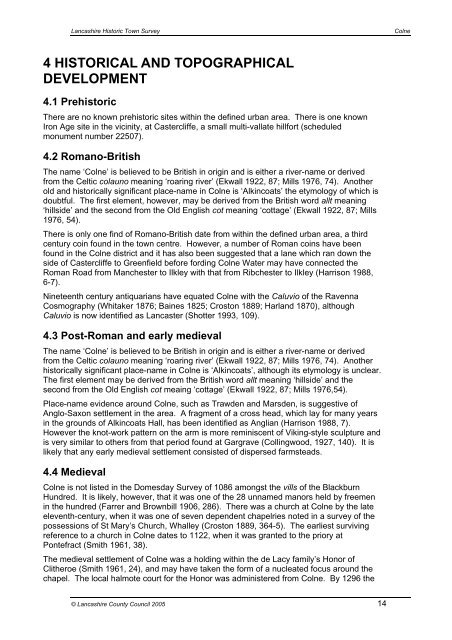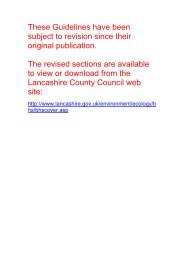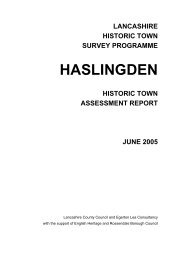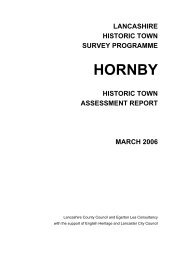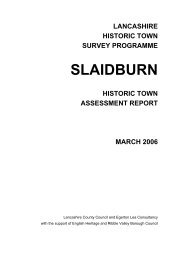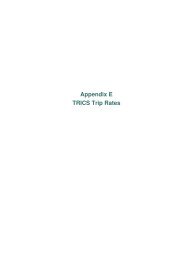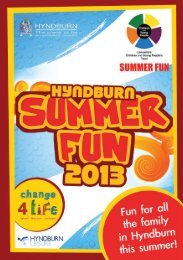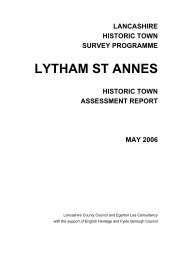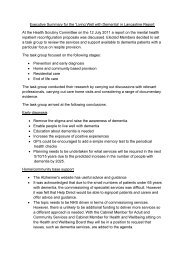Colne - Lancashire County Council
Colne - Lancashire County Council
Colne - Lancashire County Council
You also want an ePaper? Increase the reach of your titles
YUMPU automatically turns print PDFs into web optimized ePapers that Google loves.
<strong>Lancashire</strong> Historic Town Survey<strong>Colne</strong>4 HISTORICAL AND TOPOGRAPHICALDEVELOPMENT4.1 PrehistoricThere are no known prehistoric sites within the defined urban area. There is one knownIron Age site in the vicinity, at Castercliffe, a small multi-vallate hillfort (scheduledmonument number 22507).4.2 Romano-BritishThe name ‘<strong>Colne</strong>’ is believed to be British in origin and is either a river-name or derivedfrom the Celtic colauno meaning ‘roaring river’ (Ekwall 1922, 87; Mills 1976, 74). Anotherold and historically significant place-name in <strong>Colne</strong> is ‘Alkincoats’ the etymology of which isdoubtful. The first element, however, may be derived from the British word allt meaning‘hillside’ and the second from the Old English cot meaning ‘cottage’ (Ekwall 1922, 87; Mills1976, 54).There is only one find of Romano-British date from within the defined urban area, a thirdcentury coin found in the town centre. However, a number of Roman coins have beenfound in the <strong>Colne</strong> district and it has also been suggested that a lane which ran down theside of Castercliffe to Greenfield before fording <strong>Colne</strong> Water may have connected theRoman Road from Manchester to Ilkley with that from Ribchester to Ilkley (Harrison 1988,6-7).Nineteenth century antiquarians have equated <strong>Colne</strong> with the Caluvio of the RavennaCosmography (Whitaker 1876; Baines 1825; Croston 1889; Harland 1870), althoughCaluvio is now identified as Lancaster (Shotter 1993, 109).4.3 Post-Roman and early medievalThe name ‘<strong>Colne</strong>’ is believed to be British in origin and is either a river-name or derivedfrom the Celtic colauno meaning ‘roaring river’ (Ekwall 1922, 87; Mills 1976, 74). Anotherhistorically significant place-name in <strong>Colne</strong> is ‘Alkincoats’, although its etymology is unclear.The first element may be derived from the British word allt meaning ‘hillside’ and thesecond from the Old English cot meaing ‘cottage’ (Ekwall 1922, 87; Mills 1976,54).Place-name evidence around <strong>Colne</strong>, such as Trawden and Marsden, is suggestive ofAnglo-Saxon settlement in the area. A fragment of a cross head, which lay for many yearsin the grounds of Alkincoats Hall, has been identified as Anglian (Harrison 1988, 7).However the knot-work pattern on the arm is more reminiscent of Viking-style sculpture andis very similar to others from that period found at Gargrave (Collingwood, 1927, 140). It islikely that any early medieval settlement consisted of dispersed farmsteads.4.4 Medieval<strong>Colne</strong> is not listed in the Domesday Survey of 1086 amongst the vills of the BlackburnHundred. It is likely, however, that it was one of the 28 unnamed manors held by freemenin the hundred (Farrer and Brownbill 1906, 286). There was a church at <strong>Colne</strong> by the lateeleventh-century, when it was one of seven dependent chapelries noted in a survey of thepossessions of St Mary’s Church, Whalley (Croston 1889, 364-5). The earliest survivingreference to a church in <strong>Colne</strong> dates to 1122, when it was granted to the priory atPontefract (Smith 1961, 38).The medieval settlement of <strong>Colne</strong> was a holding within the de Lacy family’s Honor ofClitheroe (Smith 1961, 24), and may have taken the form of a nucleated focus around thechapel. The local halmote court for the Honor was administered from <strong>Colne</strong>. By 1296 the© <strong>Lancashire</strong> <strong>County</strong> <strong>Council</strong> 2005 14


